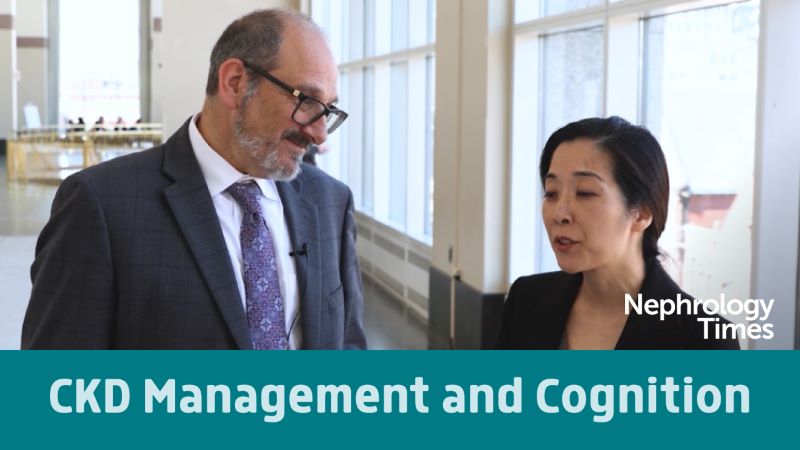
In patients with heart failure with
reduced ejection fraction (HFrEF), blockage of the renin-angiotensin-aldosterone
system with either angiotensin-converting enzyme (ACE) inhibitors or
angiotensin receptor blockers (ARBs) is beneficial in reducing the risk for
cardiovascular events. RAAS inhibition is considered an integral part of the management
of patients with HFrEF. Therapy with ACE inhibitors or ARBs lead to dilation of
the efferent arteriole in the kidney and can be associated with short-term
declines in estimated glomerular filtration rate (eGFR). Previous studies in
patients with diabetes have shown that early declines in eGFR following ACE
inhibitor/ARB initiation are associated with slower long-term declines; it is
unclear whether that trend applies to HFrEF.
A reduced level of kidney function in
patients with HFrEF is a strong predictor of poor outcomes, and the mortality
risk is increased in patients with eGFR <60 mL/min/1.73 m2. As
eGFR declines, the mortality risk increases. However, there are few available
data on longitudinal trends in patients with HFrEF. Declines in eGFR of 30% to
40% or greater as well as progression to chronic kidney disease (CKD) stage 4
are associated with increased risk for mortality and hospitalizations in the
general population; the incidence of those kidney function end points are
unclear in patients with HFrEF.
Wendy McCallum, MD, MS, and colleagues recently conducted a
post hoc analysis of trial data to describe longitudinal trends in eGFR in
HFrEF and how those changes are influenced by ACE-inhibitor therapy. Results of
the analysis were reported in the American Journal of Kidney Diseases [2020;75(1):21-29].
The researchers utilized data from
SOLVD (Studies of Left Ventricular Dysfunction), two multicenter, double-blind,
randomized controlled trials sponsored by the National Heart, Lung, and Blood
Institute. The two studies (Treatment Trial and Prevention Trial) were designed
to assess the effects of the ACE inhibitor enalapril versus placebo on
mortality in patients with HFrEF (ejection faction <35%).
The outcomes of interest of the
current analysis were annual rate of decline in eGFR as well as four kidney
function end points: (1) increase in serum creatinine level ≥0.3 mg/dL; (2)
decline in eGFR >30% from baseline; (3) decline of eGFR >40%; and (4)
incident eGFR <30 mL/min/1.73 m2.
A total of 2423 patients from the
Treatment Trial and 4094 from the Prevention Trial were included in the
analysis. Mean age was 60 years in the Treatment Trial and 59 years in the
Prevention Trial; the Treatment Trial had a slightly higher percentage of women
(19% vs 11% in the Prevention Trial). Baseline characteristics were generally
similar across randomly assigned groups within each trial. There was a greater
prevalence of diabetes, hypertension, and use of a diuretic in Treatment Trial
participants; baseline eGFR was also worse in Treatment Trial participants
(eGFR 69.5 mL/min/1.73 m2 vs 76.2 mL/min/1.73 m2 in the
Prevention Trial).
Median follow-up was 34 months
(range, 0.5 to 62.3 months). Among patients who were alive and reached each
follow-up visit, there was no substantial difference in missing eGFR data by randomization
arm in either trial.
There were early declines in eGFRs
that were more pronounced in the enalapril arms of both trials, followed by
parallel progressive declines in eGFRs over the remaining course of follow-up.
There were no statistical differences in slopes during the median 3-year
follow-up in either the Treatment Trial: –0.84 mL/min/1.73 m2 in the
enalapril arm versus –1.36 mL/min/1.73 m2 in the placebo arm (P=.08)
or the Prevention Trial: –1.27 mL/min/1.73 m2 in the enalapril arm
versus –1.36 mL/min/1.73 m2 in the placebo arm (P=.7).
In the first 6-week period of the
Treatment Trial, random assignment to the enalapril arm increased the risk for
all four outcomes of interest: hazard ratio [HR], 1.48 (95% confidence interval
[CI], 1.10-1.99) for creatinine increase by ≥0.3 mg/dL; HR, 1.38 (95% CI,
0.98-1.94) for eGFR decline >30%; HR, 2.60 (95% CI, 1.30-5.21) for eGFR
decline >40%; and HR, 4.71 (95% CI, 1.78-12.50) for eGFR <30 mL/min/1.73
m2. After the first year, there was no significant association
between treatment with enalapril and increased risk.
In the Prevention Trial, there was a
similar, but less pronounced, pattern, with risks present only in the early
period.
Limitations to the study cited by the
authors included the exclusion of patients with serum creatinine levels >2.5
mg/dL from the original trial, and not collecting urinalyses as part of the
trial.
In conclusion, the researchers said,
“On average, decline in eGFR was relatively slow in both symptomatic and
asymptomatic patients with HFrEF and only a small percentage reached incident
CKD stages 4 to 5 during a median follow-up of 3 years. Random assignment to
enalapril treatment only minimally hastened the progression of decline in
kidney function. Despite a slightly increased risk for reaching several kidney
function surrogate end points, the overall incidence of these end points was
low and occurred early. Renin-angiotensin-aldosterone system inhibitors have
been shown to have a clear mortality benefit for patients with HFrEF, as
demonstrated in multiple landmark trials including SOLVS, and it is encouraging
that their use appears to have minimal added risk for detriment to kidney
function, although admittedly also no kidney benefit.”
Takeaway Points
- Patients with heart failure with
reduced ejection fraction benefit from treatment with either
angiotensin-converting enzyme (ACE) inhibitors or angiotensin receptor blockers
(ARBs), but it is not known whether early declines in estimated glomerular
filtration rate (eGFR) following initiation of ACE-inhibitor/ARB therapy are
associated with slower long-term declines. - Researchers conducted a post hoc
analysis of data from the Studies of Left Ventricular Dysfunction (SOLVD) trials
(the Treatment Trial and the Prevention Trial). - Random assignment to the enalapril
arm in both trials resulted in statistically increased risk for four kidney
surrogate end points; the risk was limited to the early trial phase and the
overall incidence of the end points was low.







 © 2025 Mashup Media, LLC, a Formedics Property. All Rights Reserved.
© 2025 Mashup Media, LLC, a Formedics Property. All Rights Reserved.